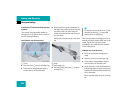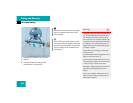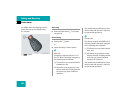
87
Safety and Security
Driving safety systems
BAS
The Brake Assist System (BAS) operates in
emergency situations. If you apply the
brakes very quickly, the BAS automatically
provides full brake boost, thereby poten-
tially reducing the braking distance. Apply
continuous full braking pressure until the
emergency braking situation is over. The
ABS will prevent the wheels from locking.
When you release the brake pedal, the
brakes function again as normal. The BAS
is then deactivated.
ESP
The Electronic Stability Program (ESP)
monitors the vehicle's traction (force of
adhesive friction between the tires and the
road surface) and handling.
The ESP recognizes when a wheel is spin-
ning or if the vehicle starts to skid. By ap-
plying brakes to the appropriate wheel and
by limiting engine output, the ESP works to
stabilize the vehicle. The ESP is especially
useful while driving off and on wet or slip-
pery road surfaces.
The ABS/ESP warning lamp v in the
instrument cluster flashes when the ESP is
engaged.
The ABS/ESP warning lamp v in the
instrument cluster comes on when you
switch on the ignition. It goes out when the
engine is running.
Warning! G
If the BAS is malfunctioning, the brake sys-
tem is still functioning normally, but without
the additional brake boost available that
BAS would normally provide in an emergen-
cy braking maneuver. Therefore, the braking
distance may increase.
Warning! G
The BAS cannot prevent the natural laws of
physics from acting on the vehicle, nor can
it increase braking efficiency beyond that
afforded by the condition of the vehicle
brakes and tires or the traction. The BAS
cannot prevent accidents, including those
resulting from excessive speed in turns, fol-
lowing another vehicle too closely, or hydro-
planing. Only a safe, attentive, and skillful
driver can prevent accidents. The capabili-
ties of a BAS equipped vehicle must never
be exploited in a reckless or dangerous
manner which could jeopardize the user’s
safety or the safety of others.


















